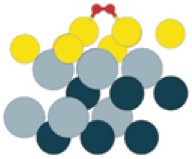Topological catalysis
When they occur at the surface of a material, electronic states are most vulnerable to contamination and defects. One of the fascinating aspects of the recently discovered topological insulators—materials that are bulk insulators but have conducting surface states—is the robustness of the surface states to perturbations. While this property has mostly been a signature of a topological insulator, an intriguing idea is to exploit this robustness for studying the physics of surface interactions.
In a paper published in Physical Review Letters, Hua Chen from the University of Tennessee and collaborators report a theoretical study of carbon monoxide oxidation. Using density-functional calculations, they find that the robust topological surface states significantly enhance the adsorption energy for both carbon monoxide and oxygen molecules. Effectively, the topological surface states act as an electron bath, making oxygen molecules more prone to dissociate on the gold-covered topological insulator, something oxygen does not do on pure gold. These findings have potential implications for surface science as well as catalysis. – Daniel Ucko





